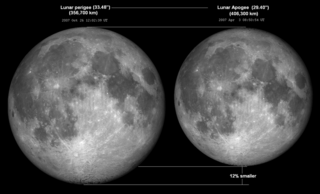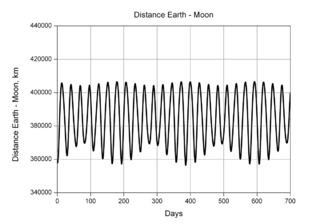Lunar distance (astronomy)

In astronomy, a lunar distance (LD) is a measurement of the distance from the Earth to the Moon. The average distance from the center of the Earth to the center of the Moon is 384,400 km (238,900 mi).[1] One astronomical unit is about 389 LD. The actual distance varies over the course of the orbit of the moon, from 363,104 km (225,622 mi) at the perigee and 405,696 km (252,088 mi) at apogee, resulting in a differential range of 42,592 km (26,465 mi).
Millimeter-precision measurements of the lunar distance are made by measuring the time taken for light to travel between LIDAR stations on the Earth and retroreflectors placed on the Moon. Lunar laser ranging measurement data is available from the Paris Observatory Lunar Analysis Center,[2] and the active stations.
The Moon is spiraling away from the Earth at an average rate of 3.8 cm (1.5 in) per year, as detected by the Lunar Laser Ranging Experiment.[3][4][5] The recession rate is considered anomalously high.[6] By coincidence, the diameter of corner cubes in retroreflectors on the Moon is also 3.8 cm (1.5 in).[7][8]
The tidal dissipation rate has varied diuring the Earth's geological history.[9]
The first person to measure the distance to the Moon was the 2nd-century-BC astronomer and geographer Hipparchus, who exploited the lunar parallax using simple trigonometry, measuring the distance as 400,000 kilometers. He was approximately 26,000 km (16,000 mi) off the actual distance, an error of about 6.8%.
The NASA Near Earth Object Catalog includes the distances of asteroids and comets measured in Lunar Distances.[10]

Moon phases: 0 (1) - new moon, 0.25 - first quarter, 0.5 - full moon, 0.75 - last quarter.
See also
- Orbit of the Moon
- Lunar Laser Ranging Experiment
- Astronomical unit
References
- ↑ NASA Staff (10 May 2011). "Solar System Exploration - Earth's Moon: Facts & Figures". NASA. Retrieved 2011-11-06.
- ↑ "LUNAR LASER RANGING OBSERVATIONS FROM 1969 TO MAY 2013" SYRTE Paris Observatory, retrieved 3 June 2014
- ↑ http://curious.astro.cornell.edu/question.php?number=124 Is the Moon moving away from the Earth?
- ↑ C.D. Murray & S.F. Dermott (1999). Solar System Dynamics. Cambridge University Press. p. 184.
- ↑ Dickinson, Terence (1993). From the Big Bang to Planet X. Camden East, Ontario: Camden House. pp. 79–81. ISBN 0-921820-71-2.
- ↑ Bills, B.G., and Ray, R.D. (1999), "Lunar Orbital Evolution: A Synthesis of Recent Results", Geophysical Research Letters 26 (19): 3045–3048, Bibcode:1999GeoRL..26.3045B, doi:10.1029/1999GL008348
- ↑ http://eclipse.gsfc.nasa.gov/SEhelp/ApolloLaser.html
- ↑ http://www.physics.ucsd.edu/~tmurphy/apollo/lrrr.html
- ↑ http://isotope.colorado.edu/~geol5700/Bills_1999.pdf - Lunar orbital evolution
- ↑ NEO Earth Close Approaches
